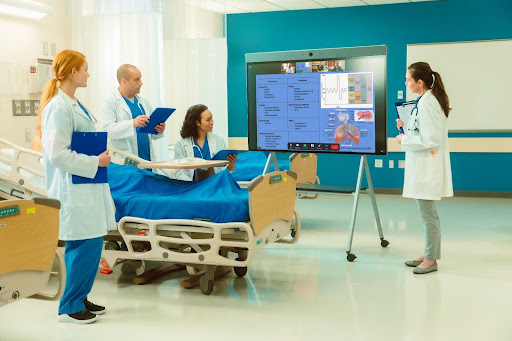
Re-imagining healthcare with Zoom’s AI-first platform
Zoom for Healthcare enables healthcare organizations to deliver seamless experiences across the patient journey and enhance collaboration among providers.
Updated on September 22, 2022
Published on December 23, 2021

At Zoom, we work closely with our healthcare and life sciences customers to understand the essential role that communication plays in patient care, research and development, operations, and more. With your insights, we improve our platform to create a more frictionless experience for healthcare professionals, patients, and families everywhere.
We’ve seen how you’ve leaned on virtual care and collaboration as the challenges of the pandemic gave way to new ways of working, living, and delivering care. As we welcome a new year ahead, here’s a roundup of what we’ve done in 2021 to help you streamline communications and improve care delivery, and a look at where we see the industry headed in 2022.
We introduced some capabilities over the past year to help our healthcare customers and their patients communicate and connect more easily during telehealth appointments.


You’ll find the following features and capabilities helpful outside the virtual doctor’s office — in department meetings, presentations, reception areas, and even administration.

 Kiosk Mode: You can set up a virtual receptionist in your lobby to greet patients and direct them to their appointment while reducing the risk of exposure.
Kiosk Mode: You can set up a virtual receptionist in your lobby to greet patients and direct them to their appointment while reducing the risk of exposure. 
In 2021, we saw even more funding opportunities available to help healthcare organizations modernize their communication systems, build their telehealth capabilities, and improve access to care. Some of these grant opportunities are still available!
Take a look at our funding resources and hear from our grant partners at Learn Design Apply to see how your organization can leverage these funds to respond, recover, and build capacity for virtual and hybrid care delivery.
What does 2022 hold in store for healthcare? First, we can predict continued innovation of digital applications in everything from care delivery to medical training. As we saw at Zoomtopia 2021, innovators in this space are developing amazing capabilities like deviceless screening to measure things like pulse and respiration without monitors or medical instruments — by using audio, video, and other technologies available on a person’s mobile phone.

Innovations like this could lead us toward a digital-first healthcare system where patients can have even more ways to connect with their care team and manage their health from home, without compromising on quality of care.
Finally, decentralization will become a major theme for health and life sciences organizations. Decentralized clinical trials are growing in popularity, enabling pharmaceutical companies and contract research organizations (CROs) to untether their research from specific trial sites, reach a more diverse pool of patients, and provide a more accessible patient experience. Not only that, decentralized business models allow healthcare and life sciences organizations to collaborate on a global scale and work with the best and brightest minds, not just the closest.
Communication is the backbone of all this innovation. Across the continuum of care, I expect video and collaboration technologies to be part of how we improve care delivery, develop life-saving drugs and devices, and enhance patient experience moving forward.
Visit the Zoom for Healthcare page to learn more about how healthcare and life sciences organizations are using Zoom.